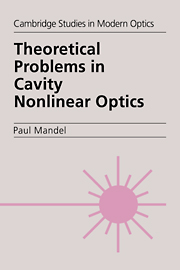Book contents
- Frontmatter
- Contents
- Introduction
- 1 Reduction of the Maxwell–Schrödinger equations
- 2 Parameter swept across a steady bifurcation I
- 3 Parameter swept across a steady bifurcation II
- 4 Optical bistability: Constant input
- 5 Optical bistability: Variable input
- 6 Multimode optical bistability
- 7 Free-running multimode lasers
- 8 Antiphase dynamics
- 9 Laser stability
- 10 Second harmonic generation
- 11 Saturable absorbers
- 12 Transverse effects in optical bistability
- Index
9 - Laser stability
Published online by Cambridge University Press: 16 October 2009
- Frontmatter
- Contents
- Introduction
- 1 Reduction of the Maxwell–Schrödinger equations
- 2 Parameter swept across a steady bifurcation I
- 3 Parameter swept across a steady bifurcation II
- 4 Optical bistability: Constant input
- 5 Optical bistability: Variable input
- 6 Multimode optical bistability
- 7 Free-running multimode lasers
- 8 Antiphase dynamics
- 9 Laser stability
- 10 Second harmonic generation
- 11 Saturable absorbers
- 12 Transverse effects in optical bistability
- Index
Summary
Laser theory has attracted a large number of studies centered on the stability problem [1]–[4]. There are at least three motivations for these studies. First, the laser equations are rather simple equations that can be derived from first principles with a minimal admixture of phenomenology. The complexity of their solutions was not fully appreciated until Haken showed the equivalence between the three single-mode laser equations on resonance [equations (1.58)–(1.60) with Δ = 0] and the Lorenz equations derived in hydrodynamics [5]. However, the domains of parameters that are relevant for optics and hydrodynamics are not the same. New asymptotic studies were suggested for the laser equations. Second, infrared lasers have been built that can be modeled quite accurately by the two-level equations, at least in some domains of parameters. A good analysis of this topic is found in [6]. A marked advantage of optics over hydrodynamics is that in general the time scales are much shorter. Hence experimental data can be accumulated, and averaging procedures can be used to separate the effect of noise from deterministic properties. Third, the laser stability becomes an essential question when the laser is used as a tool in scientific or industrial applications.
Stability means that a perturbation applied to the laser decreases in time. This requires the solution of an initial value problem that in general is too difficult to be solved analytically.
- Type
- Chapter
- Information
- Theoretical Problems in Cavity Nonlinear Optics , pp. 105 - 123Publisher: Cambridge University PressPrint publication year: 1997



